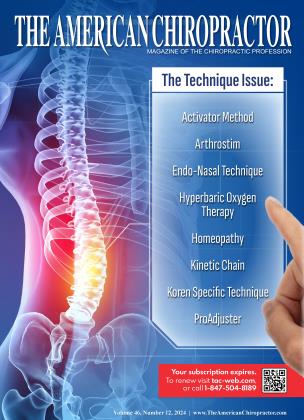By Stephan Ediss, DC, PAK, FIACA
Thomas Edison was noted for many great accomplishments throughout his life. One fortuitous famous quote leaned heavily in favor of today’s chiropractic holistic healthcare model. Edison said, “The doctor of the future will give no medicine but will interest his patient in the care of the human frame, in diet, and in the cause and prevention of disease.”
My clinical experience has shown me that more patients are looking for alternatives to prescribed medications for many reasons. A doctor of chiropractic is the best physician to look to for such alternatives because they possess the training and experience in the practice of nutritional recommendations, both dietary and nutritional supplement support. Many great recommendations can be made for a broad spectrum of conditions, but as efficacious as they are, homeopathic remedies tend to be overlooked.
Dr. Samuel Hahnemann, the founder of homeopathy, received his medical degree from the University of Erlangen in Bavaria in 1779. While practicing medicine, he quickly learned that the standardized treatments being administered were making patients sicker than the original ailment for which they sought treatment. In his quest to find an alternative treatment, he developed the central principle of homeopathy known as similia similibus curantur (“like is cured by like”) or the “law of similars.”1
Two rules of homeopathy are still practiced today. The law of similars dictates that a substance that produces similar symptoms in healthy people can cure disease and illness. The law of minimum dose means that the more diluted the homeopathic remedy, the stronger or more effective it is.2
The use of homeopathic medicines are still constructed with those rules and a variety of dilution techniques (trituration, liquid extraction, potentization, etc.). Homeopathic practitioners still use the Materia Medica to determine remedies that suit their patients’ needs. Some patients may receive one remedy, while others may receive multiple.
Remedies are typically made into cell salts, ointments, alcohol, or distilled water bases. Homeopathic remedies adhere to the fundamental rule of “first, do no harm” with minimal and rare side effects. 2 When remedies are accurately chosen, they are highly effective.3 The effectiveness of homeopathic therapy can be further enhanced by the addition of chiropractic manipulative therapy, soft tissue manipulation, and cold laser therapy.
Chiropractic manipulative therapy can stimulate the vagus nerve and the innate immune system, particularly when adjusting the upper cervical spine. Soft tissue manipulation with the intent of stimulating lymphatic flow may assist with the drainage of metabolic debris and expediting the removal of toxins. I have also found that cold laser therapy (with programmable frequency capabilities), in combination with homeopathic remedies, can increase the effectiveness of the remedy and the efficiency in which the body responds to treatment.
I was raised using homeopathic remedies because my father was a dentist and homeopathic practitioner. I have used homeopathic remedies in my practice for over 30 years to support a variety of health concerns, including:
Heavy metal detoxification (arsenicum alb., avena, berberis vulg., lycopodium, nat mur., nux vomica, phytolacca)
Parasite cleanse support (arsenicum alb., belladonna, cajuputum, capsicum, cinchona)
Postoperative recovery and soft tissue injury recovery (arnica montana, bellis perennis, hypericum)
Yeast and immune system support (echinacea, asafoetida, baptisia rhus tox, gelsemium)
Nervousness/anxiety and emotional injury support (aconitum nap, belladonna, causticum, pulsatilla, nux vomica)4
As you can see from this short list of applications, the versatility of homeopathy is vast, and the entire triad of health (structure, chemistry, and emotions) is well represented in the role of providing holistic health care. Homeopathic remedies have also been found to be beneficial for addressing hormone imbalances in some patients.
I challenge my fellow practitioners to start implementing homeopathy into their practices. You can start small and work your way into a larger repertoire as you gain experience and confidence in the efficacy of homeopathic treatment. If you are interested in how I use homeopathy in my clinic or if you have any questions, please feel free to email me.
References
1. The Editors of Encyclopedia Britannica. Samuel Hahnemann. Encyclopedia Britannica [Internet], 2024 Jun. Available from: https:// www.britannica.com/biography/Samuel-Hahnemann.
2. NIH National Center for Complementary and Integrative Medicine. Homeopathy: what you need to know. U.S. Department of Health and Human Services [Internet], 2021 April. Available from: https://www. nccih.nih.gov/health/homeopathy
3. Pedersen, T. What is homeopathy? Healthline [Internet]. 2023 Aug. Available from: https://wvvw.healthline.com/he...
4. Boericke W. Materia Medica. Free Materia Medica Books [Internet], 1901. Available from: https://www.materiamedica.info...
 View Full Issue
View Full Issue









